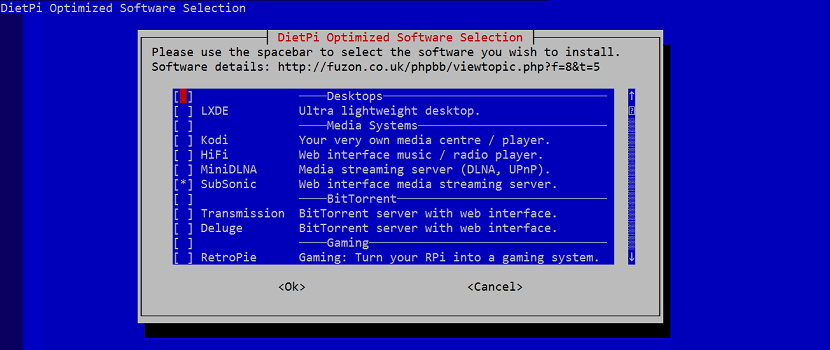
DietPi is a minimal and highly optimized Debian-based Linux distribution
Few days ago the launch of the new version of the specialized distribution «DietPi 8.17» which is intended for use on ARM and RISC-V boards such as Raspberry Pi, Orange Pi, NanoPi, BananaPi, among others.
For those who are unaware of DietPi, you should know that this is a Debian-based operating system designed for the Raspberry Pi, focuses on paring down all the clutter to deliver a sleek, lightweight operating system that can still do the heavy lifting.
With images starting at 400MB, it is highly optimized for minimal use of CPU and RAM resources, ensuring that your Raspberry Pi always runs to its full potential. The list of included software includes media centers like Kodi and Emby, torrent clients, cloud backup systems like ownCloud, and even WordPress support.
Main news of DietPi 8.17
In this new released version of DietPi 8.17 it is highlighted that updated builds based on the Debian 11 and Debian 12 repositories are now provided.
Another novelty that stands out is that this launch includes new applications which are: the openHAB smart home control system, the Moonlight GameStream client and the Restic backup utility.
For the part of the improvements that were made, we can find that for:
- NanoPi R, updated udev rules so that Ethernet LEDs do not cover the LEDs of disabled Ethernet devices. If the kernel/udev has already detected an Ethernet device and an LED is configured to light on the link, it lights until the interface is configured and no link is detected.
NanoPi R6S, the device name in DietPi now shows as “NanoPi R6S/R6C” to indicate this fact.
ROCK Pi 4, a change was made to the device name to "ROCK 4", that is, the "Pi" was removed from its name. - DietPi-Banner, added a new option to show Let's Encrypt certificate statust (expiration date), when installed via dietpi-letsencrypto Certbot.
DietPi-Tools, DietPi-LetsEncryptHTTP/2 are now OOTB enabled on Nginx when HTTPS is enabled via dietpi-letsencrypt. - Full support for NanoPi R6C board, improved support for NanoPi R, ROCK Pi 4, Raspberry Pi and Quartz64 boards.
Finally, it is worth mentioning that the distribution is based on the Debian package base and is available in builds for more than 50 devices. DietPi can also be used to create compact x86_64 virtual machine and PC environments. Board builds are compact (average 130MB) and take up less storage space compared to Raspberry Pi OS and Armbian.
How to install DietPi?

For those interested in being able to test this operating system on their Raspberry Pi, should go to their official website, which you can visit from the following link.
On the website we will go to the download section that you can access in the menu that is at the top of the site, there you can get the image for your Raspberry Pi
Done the system download, it will come compressed in a .7z format. which can be unzipped with any application to extract files of this type. Now the image that was compressed has been obtained, They can record it on their Micro SD of their Raspberry Pi with the help of Etcher or do it directly with the dd command from the terminal.
With the dd command they should know what mount point their SD has, they can find this out by executing the command:
sudo fdisk -l
Or if you have Gparted installed, open the app and it will show you the mount point. Knowing this, it is enough to execute the command in the terminal as follows, where if will place the path to the system image and in of the mount point of your SD:
dd if =/ruta/a/la/imagen/de/DietPi_vXX.img of =/dev/sdX
The image has already been recorded on your Micro SD we can make some adjustments prior to the initialization of the system. This step is optional if you want your DietPi to connect via Wifi, if you are going to connect via LAN skip this step.
To do this within our computer we are going to navigate inside the SD and we will look for the file called dietpi.txt and this should be opened with the text editor of your liking.
Inside the file we will search for lines containing the following:
WIFI_SSID [0] = y WIFI_KEY [0] =
Here we are going to put the name of our network (SSID) and its password (Key)The lines we are looking for are something like this:
WIFI_SSID [0] = “elnombre-de-tu-red”
WIFI_KEY [0] =“tu-contraseña”
We saved and closed the file and now you need to put the microSD card in your Pi, plug in your keyboard and mouse as well as your Raspberry Pi power supply.
Once the system is started, they must enter the credentials to access it, which are:
- username = root
- password = dietpi
Here the system is going to be updated and it will reboot at the end of this. After restarting again they log in again.
Now to install the package of tools that the system offers, just type:
dietpi-launcher